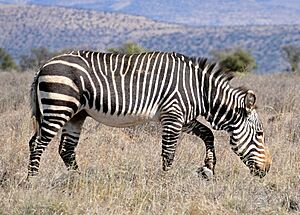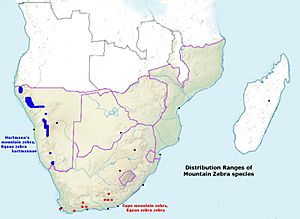Cape mountain zebra facts for kids
Quick facts for kids Cape mountain zebraTemporal range: Pleistocene - Recent
|
|
|---|---|
 |
|
| Conservation status | |
| Scientific classification |
|
| Kingdom: | Animalia |
| Phylum: | Chordata |
| Class: | Mammalia |
| Order: | Perissodactyla |
| Family: | Equidae |
| Genus: | Equus |
| Species: | |
| Subspecies: |
E. z. zebra
|
| Trinomial name | |
| Equus zebra zebra Linnaeus, 1758
|
|
 |
|
| Range map of Equus zebra zebra and Equus zebra hartmannae | |
The Cape mountain zebra (Equus zebra zebra) is a special type of mountain zebra. It lives in the mountains of the Western and Eastern Cape parts of South Africa.
This zebra is the smallest of all zebras. It also lives in the smallest area compared to other zebras. Long ago, there were very few left. But thanks to conservation efforts, their numbers are growing. The IUCN now calls them a Vulnerable animal.
Contents
Understanding the Cape Mountain Zebra
The Cape mountain zebra is one of two types of mountain zebras. The other type is called the Hartmann's mountain zebra (Equus zebra hartmannae). These two types live in different places.
Scientists used to think the Cape mountain zebra was its own species. But new studies of their genes show that both are actually types of the same mountain zebra species, Equus zebra.
What Does a Cape Mountain Zebra Look Like?
Like all zebras, the Cape mountain zebra has unique black and white stripes. No two zebras have the exact same pattern! They are medium-sized, not as big as some other zebras. They have thinner bodies and narrower hooves than the common plains zebra. Their bellies are white, similar to the Grévy's zebra.
How Big Are They?
The Cape mountain zebra is a bit different from the Hartmann's mountain zebra. It is stockier, meaning it looks a bit more solid. It also has longer ears and a larger dewlap (a fold of skin under its throat).
Adult Cape mountain zebras are about 116 to 128 cm (about 45 to 50 inches) tall at the shoulder. Females weigh around 234 kg (516 lbs). Males are a bit heavier, weighing about 255 kg (562 lbs).
Their Unique Stripes
The stripes on the Cape mountain zebra are narrower than on other zebra species. This means they have more stripes! The stripes on their heads are the narrowest. The stripes on their bodies are also narrow.
On their back legs, the stripes are wider and go all the way down to their hooves. Unlike the plains zebra, they don't have "shadow stripes" (fainter stripes between the main ones). The dark stripes stop suddenly at their sides, leaving their bellies white.
Where Do Cape Mountain Zebras Live?
In the past, Cape mountain zebras lived all over the mountain areas of the Cape Province in South Africa. Today, they mostly live in special mountain reserves and national parks. The main place is the Mountain Zebra National Park. You can also find them in places like Gamka Mountain Reserve and Karoo National Park.
As their name suggests, these zebras live in mountains. They like slopes and high plateaus. In summer, they can be found as high as 2,000 meters (about 6,500 feet) above sea level. In winter, they move to lower areas.
Daily Life of a Cape Mountain Zebra
Cape mountain zebras are most active during the day, especially in the early morning and late afternoon. They usually drink water twice a day. They also enjoy taking a dust bath every day.
What Do They Eat?
Cape mountain zebras are graminivores, which means they mainly eat grasses. They are picky eaters! They prefer greener, leafy plants. Some of their favorite grasses are the South African red grass and the weeping lovegrass. In some habitats, they also eat young shoots and underground bulbs. They usually avoid tough, short grasses or dying leaves.
These zebras eat grass that is quite tall. If there are too many other animals, like springbok, that eat grass very short, it could be bad for the zebras. This is because the grass might become too short for them to bite.
How Do They Live Together?
Cape mountain zebras do not claim their own territory. They live in small groups. There are two types of groups: breeding groups and bachelor groups.
A breeding group has one adult male (stallion), up to five females (mares), and their young (foals). Males that don't have mares join bachelor groups. Once a breeding group forms, it usually stays together for many years. Some stallions have stayed with their herds for over ten years!
Young zebras leave their herds on their own when they are about 22 months old. Unlike some other zebras, the male zebras in Cape mountain zebra herds actually try to stop their young from leaving. This might help prevent zebras from breeding with their close family members.
When two breeding herds meet, the male zebras from each herd will approach each other. They might rub bodies, touch noses, or make other contact. There is a pecking order in the group, but it doesn't seem to decide who leads the herd. Sometimes, the birth of a foal can change the social order. Females with new foals can become very protective and aggressive towards other zebras in the herd.
Having Babies
Cape mountain zebras can have babies all year round. But most births happen from December to February, which is summer in South Africa. A baby zebra is born after about one year.
A newborn foal weighs about 25 kg (55 lbs). They drink their mother's milk for about 10 months. Male zebras can start having their own families when they are 5 to 6 years old. Female zebras have their first foals when they are 3 to 6 years old. They can continue to have babies until they are about 24 years old.
Protecting the Cape Mountain Zebra
For the last 300 years, the number of Cape mountain zebras dropped a lot. This was due to too much hunting and their homes being destroyed for farms. They were once listed as Endangered. Now, they are listed as Vulnerable by the IUCN Red List. This means their population is very small, with fewer than 997 adult zebras. They are also listed on the CITES Appendix II, which means they are threatened and their trade is controlled.
Today, there are about 497 adult Cape mountain zebras. They have low genetic variation, which means they are not very diverse genetically. This can make them weaker against diseases. To help, scientists sometimes mix zebras from different groups to increase their genetic diversity.
What Still Threatens Them?
The Cape mountain zebra still faces challenges. Their habitats are being turned into farms. They also compete with farm animals for food. Hunting and other human activities are still a threat. There is also a risk of them breeding with the Hartmann's mountain zebra. This could further reduce their unique genetic diversity.
Many groups of Cape mountain zebras are small. This makes them more likely to have genetic problems or get sick. So, it's important to keep expanding and managing their populations.
Saving Them from Disappearing
The Cape mountain zebra was never found in huge numbers. By 1922, only about 400 were left. In 1936, a government official famously said they were "just a lot of donkeys in football jerseys" when asked to create a reserve for them.
But a year later, in 1937, the government created the Mountain Zebra National Park. Sadly, the small group of zebras there died out by 1950. That same year, new zebras were brought in from nearby farms.
Eleven zebras were donated in 1950, and another small group was added in 1964. By the late 1960s, there were only 140 Cape mountain zebras in total. But by 1979, the number grew to 200, with most living in the Mountain Zebra National Park. By 1984, the population was back to 400 individuals. Since then, some zebras have been moved to the Cape Point Section of Table Mountain National Park.




